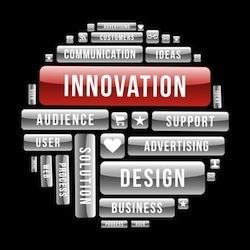Business Innovation
There are six major components to this program and one some companies need is Business Innovation.

Business Innovation is about finding out what it is about your business that is unique. What does your product or service offer that competitors don’t? What about your services makes them remarkably different than the services your customers could get from other businesses? Because this does sometimes involve innovating your business, product or service, we refer to it as Business Innovation. (And we have a number of processes to help you do that)
There’s a very easy way to illustrate the point. Imagine that your company devised a computer controlled car that flies itself. This is so innovative, it’s revolutionary! However, most marketing consultants out there would immediately start thinking up slogans:
- Super Efficient Transportation!
- Fly to Work!
- Save Time!
- Welcome to the Jetson Age!
Again, the mistake they’re making here is that these slogans, which are probably close to what you’d get from a company that produced your advertisements, are all platitudes. Contrast those with this:
THIS CAR FLIES ITSELF! FORGET DRIVING OR EVEN PILOTING! THIS ISN’T SCIENCE FICTION – THIS IS THE REAL DEAL! SERIOUSLY.
The second example emphasizes your business innovation. It lets the reader know that your product is far more innovative than your competitors. This is an easy case, obviously, because you’re telling your customers that they should buy from you because your automobile flies, which is amazingly innovative.
I’m willing to bet that you can find something equally innovative about your business, advertise that and dispense with the platitudes.
Here’s a case study example from our own work. We worked with a heating and air conditioning (HVAC) company. In working with them, we determined that one of the biggest challenges for these companies is that people get understandably nervous about having strangers in their homes. Every company out there says that their employees are background checked and drug tested, so that really doesn’t pass the “Well, I Would Hope So,” and the Cross Out/Write In test. We decided to produce a code of standards for his business that no other business in his area has. It consists of 17 different requirements that his technicians need to meet. They include the usual—background checks, certifications, etc.—but also include ethical requirements, dress code, appearance and so forth. If one of his technicians uses profanity while they’re working on a job, that customer is entitled to 100% of their money back.
Nobody in his market can say the same of their technicians. This is the nature of innovation. We’ve done similar work for plumbers, creating a Customer’s Bill of Rights so that the customer, right off the bat, gets a guarantee as to the quality of service they’ll receive and they get it in specific terms. Again, none of this plumber’s competition can say as much.
 Here’s the real benefit. Remember this: the amount of money that your customers are willing to pay is directly proportional to the amount of confidence they have in your ability to deliver. This comes down to increasing their perception of value. Consider it in terms of food.
Here’s the real benefit. Remember this: the amount of money that your customers are willing to pay is directly proportional to the amount of confidence they have in your ability to deliver. This comes down to increasing their perception of value. Consider it in terms of food.
Would you buy a fast food burger for $20? Not if you’re smart; it’s not worth it. What about a combo meal for $20? Hopefully not. What about a New York Strip from a Ruth Chris? Probably, yes, you would. In that last instance, you’d pay because you know that the value is there. But how do you know that? The burger from the fast food restaurant is made out of the same 100% beef as the steak, so there’s really no difference there. Both of them satisfy hunger and taste good, so there’s no difference there. It’s simply because you perceive that the value is there with the New York Strip and because you know the reputation of Ruth Chris Steakhouse; because of that, you’ll pay the money for the meal.
There are many different ways that you can innovate what your business has to offer. For instance, if you were a dentist and you know, right off the bat that some people get really irritated when they have to wait more than 10 or 15 minutes after their appointment time to get treated. Maybe you could offer a free neck massage in the meantime. You could even offer a free teeth cleaning. But it doesn’t even have to go that far. You could offer free Wi-Fi in the waiting area, for instance, which helps people to pass the time.
The key to making innovation work is making sure that it addresses a legitimate need. You can’t just do something different for the sake of being different. In the HVAC example, the code of standards addressed the need that people have to trust the service people who come into their homes to work. In the dentist example, the innovation addressed the nuisance of being seen late for an appointment. In the car example, the innovation is that you fly to your destination.
Your innovation must define you as not only different from the prospect’s other options, but as different in a remarkably valuable regard.
We have 12 different innovation formulas that we use with our clients. They are all scientific and they allow us to make sure that what we’re doing for our clients is tailored to their unique needs. We only have time to go through the “Ultimate Solution” right now, but it’s easy to do.
Take a piece of paper and write down a negative situation that your customers would have when doing business with someone in your industry. Now, write down what those customers would change about the situation so that they could eliminate that negative. This method works for all of the situations described above: people don’t trust their HVAC techs so you give them reason to trust them; people frustrated with traffic, so you make a car that flies over it; people hate waiting at the dentist so you make it more enjoyable.
This simple method can open up a lot of doors toward improving your business and, of course, can really help you to innovate what you do. Have a brainstorming session about it. Throw out any ideas you have about a negative that applies to your business and how you could change it. The results can be spectacular.
What to do next?
Tell us about your project